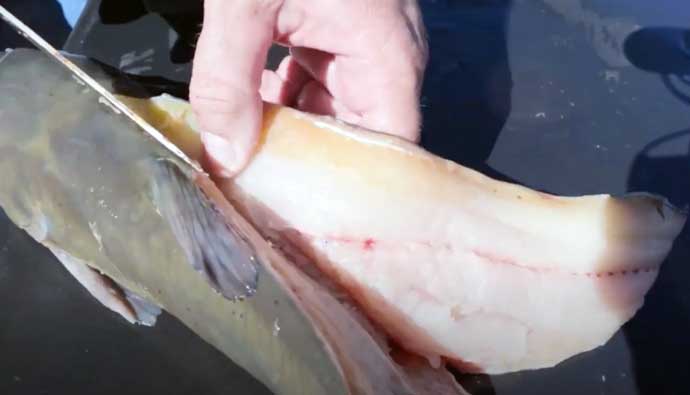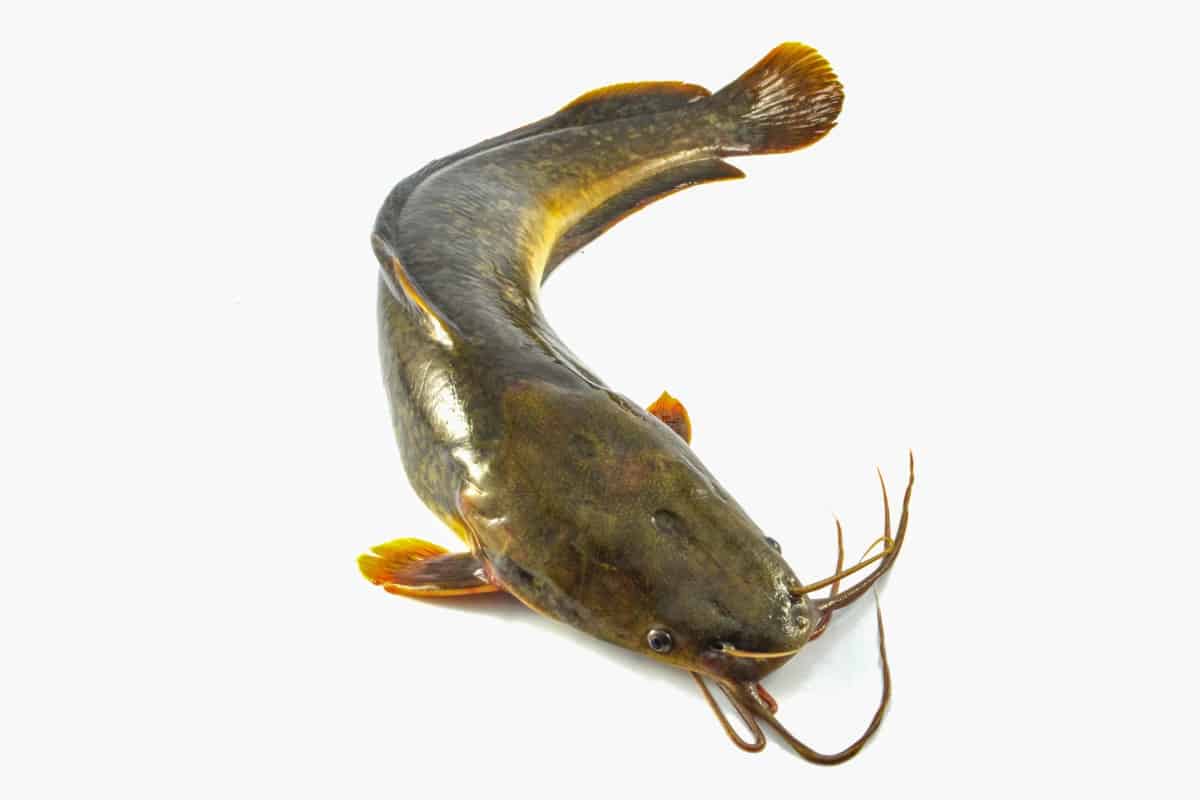
When filleting catfish, clean and wipe it with an abrasive cloth to remove as much slime as possible. Once the catfish is clean, place it on a clean surface. Start by cutting from the adipose fin; ensure you do so using the tip of your fillet knife. You’ll encounter a big wedge of meat on the right side of the head. Cut it starting from the head to the pelvic fin. This way, you won’t puncture the internal organs. Next, cut along the rib cage carefully, and ensure you avoid the barb present on the end of the dorsal fin because they contain toxins. Next, make an incision at the bottom and a horizontal cut above the tail. Ensure you make several passes under the cut fillet to detach it from the rest of the fish. Remove the excess fat around the edges and skin using a sharp knife. Once done, clean the fillets with cold water and dry them with a paper towel. Lastly, properly dispose of the skeleton and the gut, and clean the working surface.
Catfish have firm slimy skin and bones, and knowing how to clean and fillet them is essential. Here are seven simple steps you can use when cutting your next catfish.
7 Easy Steps on How to Fillet a Catfish
What You’ll Need:
- cutting board
- fiillet knife
- burlap sack or any abrasive cloth
- sharp broad knife
- paper towel
Step by Step Guide to Fillet a Catfish
Here’s a step by step guide to fillet catfish. Get your fillet knife ready. We’re filleting catfish today. To get the fillet, you’ll only need the area behind the dorsal fin. Let’s start with cleaning fresh catfish.
- Step 1
Remove as much slime from the catfish as possible. Take a burlap sack or any abrasive cloth and wipe the fish from top to bottom by passing the fabric multiple times.
This will keep everything cleaner, and you will not have difficulty grabbing the fish as you fillet it. - Step 2
Place the catfish on a clean work surface. A large cutting board will do. Then, cut the fish meat from the adipose fin using the tip of the fillet knife. Make your way upright to the dorsal or top fin.
You will encounter a big wedge of meat right on the front on top of the head. Use your flexible fillet knife to cut around. (You can also start from the top of the catfish to the pelvic fin.) This helps you avoid puncturing the internal organs. - Step 3
Then cut along the fish’s belly but don’t cut through them completely. Do this throughout the length of the rib cage. Make sure you don’t puncture any internal organs.
Also, be careful of the sharp barb found at the end of the dorsal when you cut. This may contain toxins. - Step 4
Use the fillet knife tip to make an incision at the bottom and cut down to the tail fin. Make a horizontal cut above the tail where the fillet ends.
- Step 5
Take a sharp, broader, big knife and make several passes or cuts under the loosened fillet until it comes off. Don’t cut in a hurry. Take your time making the passes, or you may end up with less meat than you want.
- Step 6
Trim off any fat that is on the edges.
- Step 7
Skin the fillets with a sharp knife. This can take a few minutes. Just use another knife to pin the extended skin down on the work surface and pass another knife between the skin and the meat. You may need to pull the skin off with your hand as well.
Then, wash the fillets in water and use a paper towel to pat the fish dry. Now, you have a clean catfish ready for cooking. Then, repeat the same technique for your next catfish. - Step 8
Clean up. Dispose of the head, skeleton, and guts properly. These make great fertilizers in the garden.

How to Remove Slime from a Catfish
Besides using a coarse cloth, there are several methods you can use to remove the slime from the fish before you fillet a catfish. You can rub it with a cut-up lemon and hot water. Use fish-cleaning gloves for a better grip.
What Happens if You Puncture the Gut?
If you puncture the catfish’s gut while filleting it, you will poison it. The damaged gut will release bacteria and enzymes, spoiling the fish faster.
You won’t be able to fillet a catfish this way. This is why you must be aware of the internal organs when cutting. You can do this by cutting a diagonal line to the front of the pelvic fin.
What to Do With Catfish Carcasses?
If you are filleting the fish over the water where you caught it, don’t dump the carcass back in. Some states have restrictions against it.
Instead, take the carcass home and use it as a natural fertilizer. These contain a lot of nutrients, such as potassium and nitrogen. You can also use the catfish carcass to make fish stock for other seafood recipes.
Should You Keep the Big Catfish to Eat?
Bigger catfish, especially trophy catfish, may look delicious, but the meat is not as tasty as you may think.
Big cats are loaded with pollutants, and the bigger the catfish, the more poisonous it is. It also has high levels of mercury and PCBs, which are harmful to humans.
A smaller catfish (around 3 to 5 pounds) on your fish scales is the perfect size to eat. These fish have a mild and sweet taste and do not taste muddy if they are filleted correctly. Giant catfish should be released into the water after it is caught.
Do Catfish Feel Pain?
According to neurobiologists, fish do not feel pain as we do. They do not have a conscious awareness of pain because they do not have certain nerve fibers that we have, which are involved in the intense sensation of pain.
Can You Use Electric Fillet Knives?
An electric fillet knife is a good substitute if you need to prepare a lot of catfish fast. It has a precise cut. With its motor and gearing, you can cut through the meat quickly with any quality electric fillet knives.
Best Way to Preserve Catfish after Catching It
Got a live fish? If you plan on filleting the fish onshore and have a long day of fishing planned, store it in ice, or it’ll start to spoil. Use crushed or flaked ice to increase the surface area contact with the fish.
Just cover the bottom of a cooler with ice, place the fish over it, and cover it with more ice.
You can cool it faster by making an ice slurry using seawater. Just remember to add more ice as the day progresses to replace the ice that melts. Use ice that is made from drinking water or water that you are 100% sure is clean.
When you return home, store the fish in the coldest part of your refrigerator in a container that won’t leak. Freeze it if you don’t plan on cooking it soon. Save it for next time and double the cooking time to cook frozen fish properly.
Best Way to Store Catfish Fillets
First, rinse and dry one catfish fillet using a paper towel. Place it in a Ziploc bag and press out the air before zipping it closed.
After that, place the bag on top of a plate lined with ice and place more ice on top before popping the plate into the refrigerator. This technique should keep the fish fresh for three to four days.
Ensure your hands are clean, or you may inadvertently transfer bacteria to the fish and skin, which may spoil it quickly.
Plus, do not stack the catfish fillet on top of one another in the refrigerator. That will only expose them to each other’s moisture and create a bacteria-friendly environment.
Plus, cover the fish before storing it. Your refrigerator is quite dry, and you don’t want your fish to dry out completely. This will come in handy if you keep the fish whole.
Catfish Recipe
Ingredients
- 4 to 6 ounces of fillets
- Salt and pepper to taste
- All-purpose flour
- 2 tbsp of unsalted butter
- ½ a cup of dried white wine
- 2 tbsp of capers (drained and rinsed)
- Two cloves of garlic (finely chopped)
- Three cups of salad greens
- ½ a cup of fresh parsley
Preparation
- Pat the clean catfish fillets dry and season with salt and pepper.
- Dredge the fillets in the flour in a shallow bowl and shake off the excess.
- Heat 1 tbsp of butter and olive oil in a nonstick skillet over medium-high heat.
- Add the fillets to the pan and cook your fish fry till the meat turns opaque. This should take 3 minutes for each side.
- Transfer the cooked fish to a plate and cover it with foil.
- Add garlic to the same skillet and cook till it turns golden brown.
- Remove the skillet from the stove and sprinkle the lemon zest, lemon juice, and wine.
- Place the skillet back on the heat again and still till the wine reduces slightly. This should take 2 minutes tops.
- Season the sauce with salt and pepper.
- Toss the greens in a bowl with a tbsp of olive oil, salt, and pepper.
- Add 1 tbsp of butter to the skillet sauce and stir until it melts.
- Distribute the fillets into different plates and pour the sauce on each.
- Wipe the skillet clean and put it over high heat before adding parsley and capers.
- Fly to a crisp and sprinkle over the fish as a garnish.
- Serve with lemon wedges and salad.
Frequently Asked Questions
The slime protects the scales and fins underneath, and since this species has fewer scales, it has a thicker layer of slime compared to other fish. The coating protects it from bacteria and also heals wounds.
Most catfish species use venom to protect themselves, and some in North America have a sting that can be quite painful. Some can even kill a fully grown man.
Most of today’s catfish are farm-raised catfish, so they are a clean source of protein. Catfish that are caught in the wild usually have a muddy taste because of their high fat content.
The flavor of farmed varieties is mild and sweet in comparison. Catfish make great Texas-style fried catfish.
The whiskers of a live catfish are not poisonous, so that you can touch those without fear. The dorsal and pectoral fins can give a nasty sting. These are located right behind the head on either side of the fish and the top behind the head as well.
Depending on your skills, you can use an electric or a regular fillet knife. Ensure the blade is sharp enough, or you can have a nasty accident. A dull knife can slip easily.
Yes, the fish has large, orderly bones, which can be easy to remove if you remove the head first. However, you might find a few small bones when cleaning catfish.
The cooked skin has few flavors, so it is often left on before the fish is cooked.
The milk removes the fishy taste before it is cooked. Simply soak the fish in milk for an hour before you cook it.
The milk doesn’t mask or soak the smell from the flesh. It reverses the chemical reaction that produces that fishy smell.
Just smell and take a look at the fish. The fish will smell sour, feel slimy to the touch, and have a duller color than when you first caught or bought it.
That should be enough to tell you that it has spoiled.




 Facebook
Facebook YouTube
YouTube









